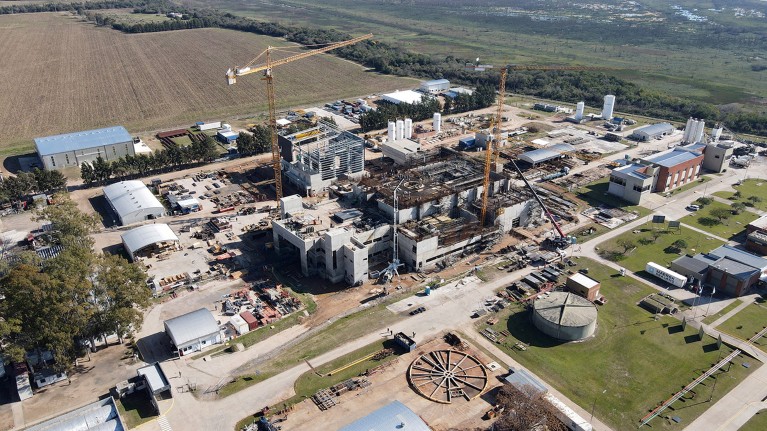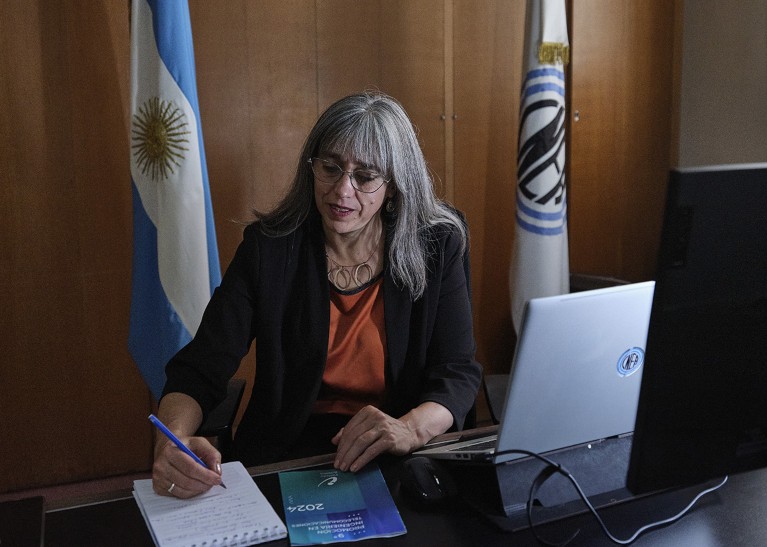
Construction of the small modular reactor CAREM, shown here in 2023 on the outskirts of Buenos Aires, in Argentina, has been paused owing to funding constraints.Credit: CNEA/Reuters
Owing to massive budget cuts and lay-offs of government employees, Argentina’s nuclear sector — which includes power plants and research facilities — is at risk, scientists say. The country was the first in Latin America to adopt nuclear energy, has three operating plants that provide about 5–10% of the nation’s electrical energy and runs numerous reactors used for research.
‘Despair’: Argentinian researchers protest as president begins dismantling science
But because Argentina’s current administration, led by far-right President Javier Milei, has held the federal budget flat compared with that in 2023, the sector is facing a financial crisis. Inflation reached more than 200% last year — meaning that, in real terms, a stagnant budget is equivalent to a funding drop of at least 50%. Milei, who took office in December after pledging to diminish the role of government in Argentina and bring the country’s debts under control, has also laid off 15,000 federal employees in the past five months.
With its current budget, the National Atomic Energy Commission (CNEA) will be able to carry out its activities only “until May or June”, according to a statement published in March and signed by the agency’s leaders. The CNEA has been operating since 1950; it sets the country’s nuclear policy and carries out research to improve “the quality of life for society”, among other responsibilities.
“All these [activities] could be in danger,” Adriana Serquis, former head of the CNEA, tells Nature. On Friday, the Milei administration at last accepted Serquis’s resignation, which she had submitted before the president took office in December.

Adriana Serquis was replaced as head of Argentina’s National Atomic Energy Commission last week.Credit: Karl Mancini
“We cannot operate with this budget,” she says. The agency has taken out loans with private firms in the past few months to keep working, she adds. CNEA authorities stressed to the Milei administration that the agency would need a 2024 budget of US$270 million to operate at a minimal level. The government guaranteed the CNEA only $100 million.
Milei has made moves towards at least partially privatizing Argentina’s nuclear sector. Yesterday, he appointed Germán Guido Lavalle, founder of candoit, an engineering and technology consulting firm based in Buenos Aires, to lead the CNEA — a move that aligns with that push.
The agency has had to pause construction on two projects that could have brought even more renown to Argentina’s nuclear sector: one is a ‘small modular reactor’ prototype that is among the first in the world to be built for electricity generation, and the other is a research reactor that might have produced enough of the radioisotope molybdenum-99, commonly used in medical diagnostic imaging, to meet 20% of global demand.
If this continues, Serquis says, “Argentina will lose its place in the ‘nuclear club’” — referring to the country’s prowess in nuclear research, a global status it has maintained among wealthy nations.
Projects stagnate
One of the stalled nuclear projects is the small modular reactor CAREM, intended to supply low-carbon electricity to rural areas where large power plants can’t be built. Nuclear scientists have been working for decades to create this type of reactor, and countries, including Argentina, have been in a race to get theirs fired up quickly. CAREM, a prototype, would use uranium fission to supply around 30 megawatts of electrical power. If successful, it could be scaled up to larger, commercial versions supplying 300 megawatts of electric power. More than $600 million has been invested into CAREM since construction began in 2014, but another $200 million to $300 million is needed to finish it.
Argentina election: front runner vows to slash science funding
“It has less electrical production capacity than a nuclear power plant, but it’s also cheaper and safer,” says Tomás Avallone, a chemist and nuclear-reactors operator at the CNEA. It could be installed anywhere, be used for high-energy-consumption activities such as water desalinization and bring power to 300,000 people, he says.
Another stagnating project is RA-10, a 30-megawatt reactor that would use neutron beams to produce medical radioisotopes. Scientists could also use RA-10 to conduct materials research. “It is a multipurpose reactor,” says Rodolfo Kempf, nuclear-waste manager at the CNEA. The main construction on RA-10 has been completed, Kempf says, but its instruments haven’t been installed.
Argentina has so far invested more than $400 million in building the reactor, and another $80 million is needed. The commercial sale of the reactor design should provide a significant return on investment, say researchers who spoke to Nature.
Privatization push
The Milei administration has been advocating for the privatization of science and education in Argentina. In April, it sent a bill to Congress that includes a list of state companies to be fully or partially privatized. Nucleoeléctrica Argentina, a state-run firm based in Buenos Aires that oversees the country’s three nuclear plants, is on the list to be partially privatized. If this comes to pass, the government would maintain the majority of Nucleoeléctrica shares, and its vote would be needed for actions including expanding the capacity of a power plant, building a new one or adding shareholders to the company.
‘Extremely worrying’: Argentinian researchers reel after election of anti-science president
Alfredo Caro, a nuclear physicist and former director of the CNEA’s Bariloche Atomic Centre, estimates that a 30% stake in Nucleoeléctrica would be worth between $700 million and $1 billion. If that stake were sold, it might allow the government to finalize the construction of CAREM and RA-10, as well as to complete a planned upgrade of the Atucha I power plant, located about 120 kilometres northwest of Buenos Aires, to extend its lifetime, he says. “A partial privatization could help the sector carry on,” Caro says, “but only if the funds that are raised remain in the sector and are not spent on other areas of the state” — a big ‘if’, given the financial crisis in Argentina. The country’s gross domestic product is expected to drop 3.3% this year, according to the Organization for Economic Co-operation and Development.
Officials at Argentina’s Secretariat of Energy and Nucleoeléctrica didn’t respond to questions from Nature about their plans for the nuclear sector. Meanwhile, the bill to privatize state companies has been approved by the lower chamber of Argentina’s Congress, and will now be considered by the Senate.

 ‘Despair’: Argentinian researchers protest as president begins dismantling science
‘Despair’: Argentinian researchers protest as president begins dismantling science
 ‘Extremely worrying’: Argentinian researchers reel after election of anti-science president
‘Extremely worrying’: Argentinian researchers reel after election of anti-science president
 Argentina election: front runner vows to slash science funding
Argentina election: front runner vows to slash science funding






